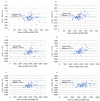Energy Requirement for Elderly CKD Patients
- PMID: 34684396
- PMCID: PMC8541480
- DOI: 10.3390/nu13103396
Energy Requirement for Elderly CKD Patients
Abstract
The correct management of energy intake is crucial in CKD (chronic kidney disease) patients to limit the risk of protein energy wasting especially during low-protein regimes, but also to prevent overweight/obesity. The aim of this study was to assess the energy requirement of older CKD patients using objective measurements. This cross-sectional study enrolled 67 patients (aged 60-86 years) with CKD stages 3-5 not on dialysis, all of whom were metabolically and nutritionally stable. All patients underwent indirect calorimetry and measurement of daily physical activity level expressed by the average daily Metabolic Equivalent Task, using an accelerometer, in order to measure total energy expenditure (mTEE). Estimated TEE (eTEE) was derived from predictive equations for resting energy expenditure and physical activity levels coefficients. The mTEE were lower than eTEE-based on Harris-Benedict or Schofield or Mifflin equations (1689 ± 523 vs. 2320 ± 434 or 2357 ± 410 or 2237 ± 375 Kcal, p < 0.001, respectively). On average mTEE was 36.5% lower than eTEE. When eTEE was recalculated using ideal body weight the gap between mTEE and eTEE was reduced to 26.3%. A high prevalence of a sedentary lifestyle and reduced physical capabilities were also detected. In conclusion, our data support the energy intake of 25-35 Kcal/Kg/d recently proposed by the NKF-KDOQI (National Kidney Foundation-Kidney Disease Improving Quality Initiative) guidelines on nutritional treatment of CKD, which seem to be more adequate and applicable than that of previous guidelines (30-35 Kcal/Kg/d) in elderly stable CKD patients with a sedentary lifestyle. According to our findings we believe that an energy intake even lower than 25 Kcal/Kg/d may be adequate in metabolically stable, elderly CKD patients with a sedentary lifestyle.
Keywords: CKD; diet; dietary energy intake; energy expenditure; indirect calorimetry.
Conflict of interest statement
The authors declare no conflict of interest.
Figures



References
MeSH terms
LinkOut - more resources
Full Text Sources
Medical
Miscellaneous

